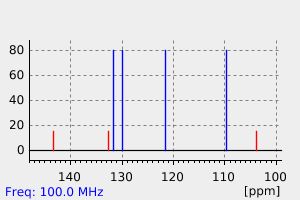1H-苯并三唑-1-甲腈 | 15328-32-2
中文名称
1H-苯并三唑-1-甲腈
中文别名
——
英文名称
1-cyanobenzotriazole
英文别名
1-cyano-1H-benzotriazole;benzotriazole-1-carbonitrile
CAS
15328-32-2
化学式
C7H4N4
mdl
MFCD00134556
分子量
144.136
InChiKey
JPUHPGALPBINPO-UHFFFAOYSA-N
BEILSTEIN
——
EINECS
——
-
物化性质
-
计算性质
-
ADMET
-
安全信息
-
SDS
-
制备方法与用途
-
上下游信息
-
文献信息
-
表征谱图
-
同类化合物
-
相关功能分类
-
相关结构分类
物化性质
-
熔点:73.4-74.8 °C
-
沸点:300.7±25.0 °C(Predicted)
-
密度:1.37±0.1 g/cm3(Predicted)
计算性质
-
辛醇/水分配系数(LogP):1.3
-
重原子数:11
-
可旋转键数:0
-
环数:2.0
-
sp3杂化的碳原子比例:0.0
-
拓扑面积:54.5
-
氢给体数:0
-
氢受体数:3
安全信息
-
海关编码:2933990090
-
包装等级:III
-
危险类别:6.1
-
危险性防范说明:P261,P280,P301+P310,P311
-
危险品运输编号:3439
-
危险性描述:H301,H311,H331
-
储存条件:| 存储条件 | 室温,储存于惰性气体中 | | --- | --- |
SDS
上下游信息
-
下游产品
中文名称 英文名称 CAS号 化学式 分子量 —— 1H-1,2,3-benzotriazole-1-carbothioamide 770738-28-8 C7H6N4S 178.217
反应信息
-
作为反应物:描述:参考文献:名称:Synthesis of Mono- and N,N-Disubstituted Thioureas and N-Acylthioureas摘要:由 1-氰基苯并三唑(1)和硫化氢制备的 1-苯并三唑-1-硫代甲酰胺(2)与胺反应生成硫脲类化合物 3a-e。(benzotriazol-1-yl)carboximidamides 4a-d,f-j 和 acyl- 5a-f,i-k 或 arylaminocarbonyl- 5g,h (benzotriazol-1-yl)carboximidamides 与硫化氢反应,分别得到相应的硫脲类化合物 3a-d,f-j,以及 N-酰基硫脲类化合物 6a-f,i-k 或 N-氨基甲酰基硫脲类化合物 6g,h。DOI:10.1055/s-2004-829127
-
作为产物:描述:参考文献:名称:A Convenient New Synthesis of 1-Cyanobenzotriazole and Its Use as a C-Cyanating Reagent摘要:DOI:10.1021/jo9717548
文献信息
-
3-ARYL PROPIOLONITRILE COMPOUNDS FOR THIOL LABELING申请人:UNIVERSITE DE STRASBOURG公开号:US20160145199A1公开(公告)日:2016-05-26The present invention relates to a process for labeling compounds comprising thiol moieties with 3-arylpropiolonitrile compounds, to 3-arylpropiolonitrile compounds substituted with tag moieties and to specific 3-arylpropiolonitrile linkers.
-
The direct electrophilic cyanation of β-keto esters and amides with cyano benziodoxole
-
Method for the preparation of citalopram申请人:H. Lundbeck A/S公开号:US20020128497A1公开(公告)日:2002-09-12A method for the manufacture of citalopram characterized in (i) reaction of 1-(4-fluorophenyl)-1-(3-dimethylaminopropyl)-5-halophthalane with an activated magnesium to form the Grignard reagent [3-[1-(4-fluorophenyl)-1,3 dihydro-isobenzofuran-1-yl]propyl]dimethylamine 5-magnesium halide followed by (ii) reaction of [3-[1-(4-fluorophenyl)-1,3 dihydro-isobenzofuran-1-yl]propyl)dimethylamine 5-magnesium halide with a compound containing a —CN group bound to a leaving group to form citalopram.
-
Cyclopentadienones as intermediates for the synthesis of highly functionalized biaryls
-
Polarizing the Nazarov Cyclization: The Impact of Dienone Substitution Pattern on Reactivity and Selectivity作者:Wei He、Ildiko R. Herrick、Tulay A. Atesin、Patrick A. Caruana、Colleen A. Kellenberger、Alison J. FrontierDOI:10.1021/ja077162g日期:2008.1.1The impact of dienone substitution on the Nazarov cyclization has been examined in detail. Substrates bearing different substituents at each of four positions on the dienone backbone were systematically probed in order to identify trends leading to higher reactivity and better selectivity. Desymmetrization of the pentadienyl cation and oxyallyl cation intermediates through placement of polarizing groups
表征谱图
-
氢谱1HNMR
-
质谱MS
-
碳谱13CNMR
-
红外IR
-
拉曼Raman
-
峰位数据
-
峰位匹配
-
表征信息
同类化合物
阿立必利
试剂4,7-Bis(5-bromo-2-thienyl)-5,6-difluoro-2-(2-hexyldecyl)-2H-benzotriazole
苯并三氮唑-N,N,N',N'-四甲基脲六氟磷酸盐
苯并三氮唑-5-甲酸乙酯
苯并三氮唑-1-基吡咯烷-1-基甲硫酮
苯并三唑-D4
苯并三唑-5(6)-甲磺酸
苯并三唑-1-羧硫代酸烯丙基酰胺
苯并三唑-1-羧硫代酸(furan-2-ylmethyl)酰胺
苯并三唑-1-羧硫代酸 2-噻唑基酰胺
苯并三唑-1-碳酰氯
苯并三唑-1-甲酰胺
苯并三唑-1-基甲基-环戊基-胺
苯并三唑-1-基氧基-三(二甲基氨基)鏻
苯并三唑-1-基丙-2-烯基碳酸酯
苯并三唑-1-基(四氢-1H-1,4-恶嗪-4-基)甲亚胺
苯并三唑-1-亚氨基丙二酸二乙酯
羟基苯并三氮唑活性酰胺
羟基苯并三氮唑活性酯
羟基苯并三唑
甲基4-氨基-1H-苯并三唑-6-羧酸酯
甲基1-乙基-1H-苯并三唑-6-羧酸酯
氯化1-(1H-苯并三唑-1-基甲基)-3-甲基哌啶正离子
曲苯的醇
异乔木萜醇乙酸酯
多肽试剂TCTU
四丁基苯并三唑盐
吡唑并苯并[1,2-a]三唑
双(1H-苯并三唑-5-胺)硫酸盐
双(1H-苯并三唑-5-胺)硫酸盐
双(1-苯并[d]三唑)碳酸酯
双(1-(苯并三唑-1-基)-2-甲基丙基)胺
卡特缩合剂
伏罗唑
伏罗唑
伏氯唑
二苯并-1,3a,4,6a-四氮杂并环戊二烯
二(苯并三唑-1-基甲基)胺
二(苯并三唑-1-基氧基)-甲基膦
二(苯并三唑-1-基)甲亚胺
二(1H-苯并三唑-1-基)甲酮
二(1H-苯并三唑-1-基)亚砜
二(1-苯并三唑基)草酸酯
二(1-苯并三唑基)甲硫酮
乙醇,2-(2-噻唑基甲氧基)-
乙酮,2-[(3-甲基-2-吡啶基)氨基]-1-苯基-
三环唑
三氮唑杂质1
三-(1-苯并三唑基)甲烷
三(苯并三唑-1-基甲基)胺







